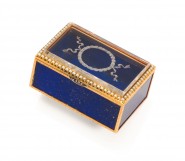Lot #53 - Kaapa (Tjampitjinpa)
-
Auction House:Mossgreen
-
Sale Name:Australian Indigenous & Oceanic Art
-
Sale Date:22 Jul 2014 ~ 6.30pm (Part 1 - Lots 1 - 198)
23 Jul 2014 ~ 2.30pm (Part 2 - Lots 199 - 331) -
Lot #:53
-
Lot Description:Kaapa (Tjampitjinpa)
(circa 1926-1989)
Wild Orange Dreaming (1971)
natural earth pigments and synthetic polymer paint on composition board
68 x 46.7 cm -
Provenance:Painted at Papunya, Northern Territory (December 1971); John Longley Snr, Victoria (1972); By descent; Private Collection, Melbourne
-
Notes:Kaapa Tjampitjinpa learned to paint with watercolour, in the style of Albert Namatjira, but was not satisfied with the constraints of representational landscape painting. Remarkably, when employed as yardman at the Papunya School, Kaapa conceived a radical new way of describing the ceremonies of celebration for his country. Evidence suggests that Kaapa's first experimental works were created before Geoffrey Bardon arrived as a fresh-faced art teacher.1 And Kaapa remained a driving force in the critical early years of contemporary Aboriginal art, becoming the first Chairman of Papunya Tula Artists.2 Kaapa's paintings developed at a rapid pace during 1971; shifting from scrupulous representations of ceremony, that included figures and ritual paraphernalia set in 'perspectival' space, such as is the award winning Men's Ceremony for the Kangaroo, Gulgardi 1971 (Araluen Arts Centre), to 'bird's-eye' renderings of ground painting designs, Untitled 1971 (Art Gallery of South Australia) and the representation of ground paintings, complete with ceremonial objects laid out with rigorous formality, Water/Rain Dreaming at Mikantji 1971 (Private Collection). Not satisfied with merely reproducing elements from ritual, Kaapa pressed on to inaugurate independent visual conventions with newfound media. Kaapa took full advantage of his flair for graphic design, composing novel geometric configurations using the vertical form of decorated poles, the oval form of ceremonial objects and mesmerizing diagonals of string crosses. These ceremonial objects were set out in conjunction with symbols derived from ground and body paint. While referring to specific ritual, Kaapa's new paintings sought to go beyond representations of those events. He sought to use the graphic potential of paint on board to express their poetry. Instead of replicating spatial relationships of the ceremonial ground, Kaapa sought to create original harmonic relationships that optimized the conventional rectangular format of European art. Kaapa's genius was to recognize that while still deriving their imagery from ceremony, his compositions could satisfy as discreet, portable artworks. The experimental Wild Orange Dreaming series, created in December 1971, was pivotal to Kaapa's artistic evolution. These were are among the first paintings in which the artist achieved a flattened picture pane, a quality that became critical to the success of Papunya Tula art, just as it had with modernist painting, from Melbourne to New York. Before comparing the two known versions of the Wild Orange Dreaming from this period, it is important to confirm the subject as a ceremony for Atwakey Wild Orange (Capparis Mitchellii), a small tree that produces an extravagant creamy-white flower from which sweet smelling yellow-green fruits form. Drawing, from his understanding of the Hermannsburg landscape tradition, Kaapa has shown the form of the plant somewhat realistically, emanating from the central roundel. Other graphic elements are derived more directly from the 'traditional' repertoire of symbols and icons. The sets of sinuous lines, spreading diagonally from the centre of the composition to the perimeter of the board, describe the plant dispersing from the 'increase centre' across the country. These sinuous lines link additional roundels representing subsidiary sites associated with the Atwakey ancestors. The elongated white ovals, attached by a line to each of these roundels are the tywerrenge (sacred bullroarers) swung by ceremonial participants, to produce an uncanny whirring, announcing the commencement of ritual. The black arcs represent windbreaks from which the performers, decorated in the guise of the Atwakey ancestors emerge. A comparison between the current work and a related Wild Orange Dreaming 1971 (Private Collection) reveals how the artist utilized contrasting compositional devices to explore the visual potential of the same ceremony.3 This work is radially symmetrical, with the same elements mirrored in each quadrant. In contrast the related Wild Orange Dreaming is based on bilateral symmetry, in which precisely the same elements are organised on each side of the sinuous path of the Atwakey ancestors. Kaapa's methodical approach to compositional experimentation is a powerful indication of his sense of purpose as an artist, in the European sense of that term. John Kean 1 Vivien Johnson, Once Upon a Time in Papunya. UNSW Press, 2010, pp. 11-30 2 Geoffrey Bardon and James Bardon, Papunya: A Place Made after the Story: The Beginnings of the Western Desert Painting Movement, Miegunyah Press, Melbourne, 2004, pp. 85-86 3 Geoffrey Bardon, Papunya Tula: Art of the Western Desert, McPhee Gribble, Melbourne, 1991, pp. 108-109
-
Estimate:A$20,000 - 30,000
-
Realised Price:
-
Category:Art
This Sale has been held and this item is no longer available. Details are provided for information purposes only.










